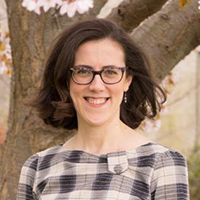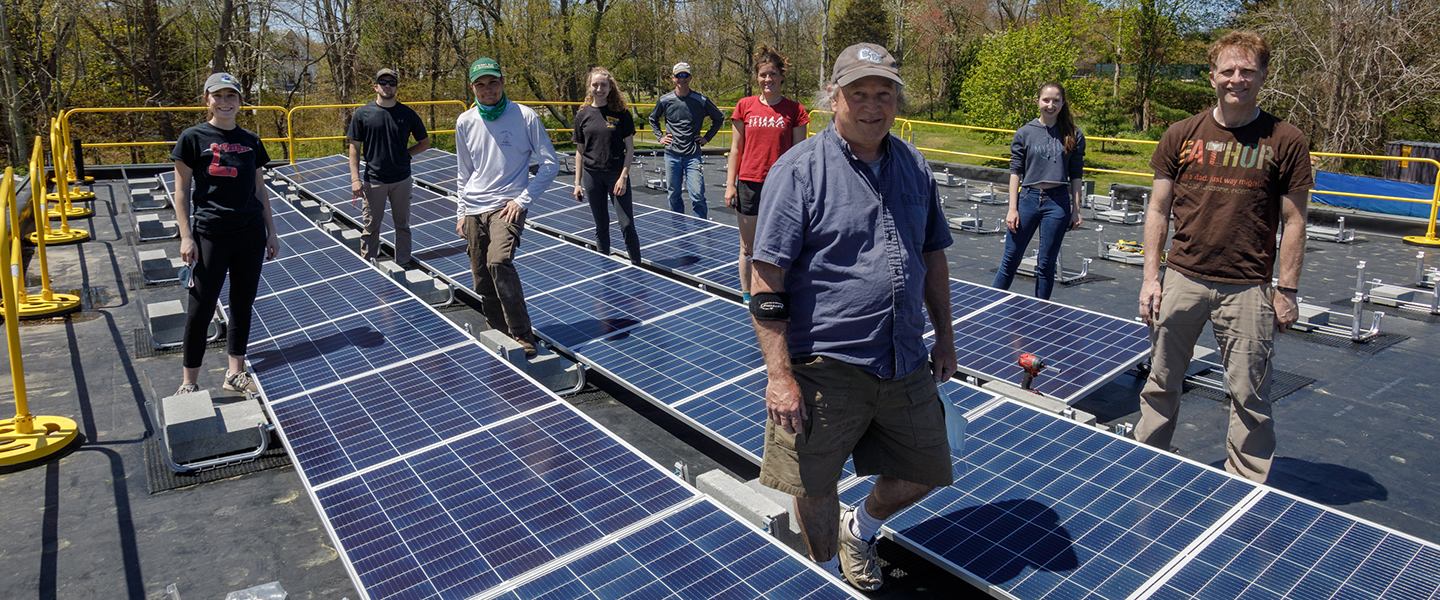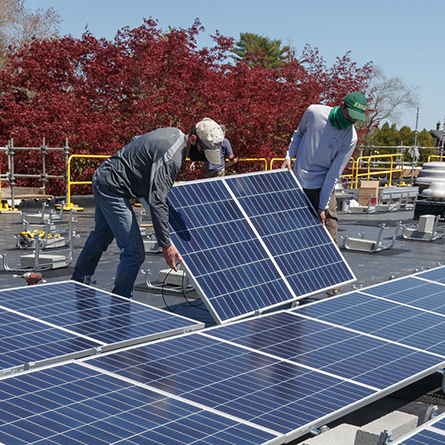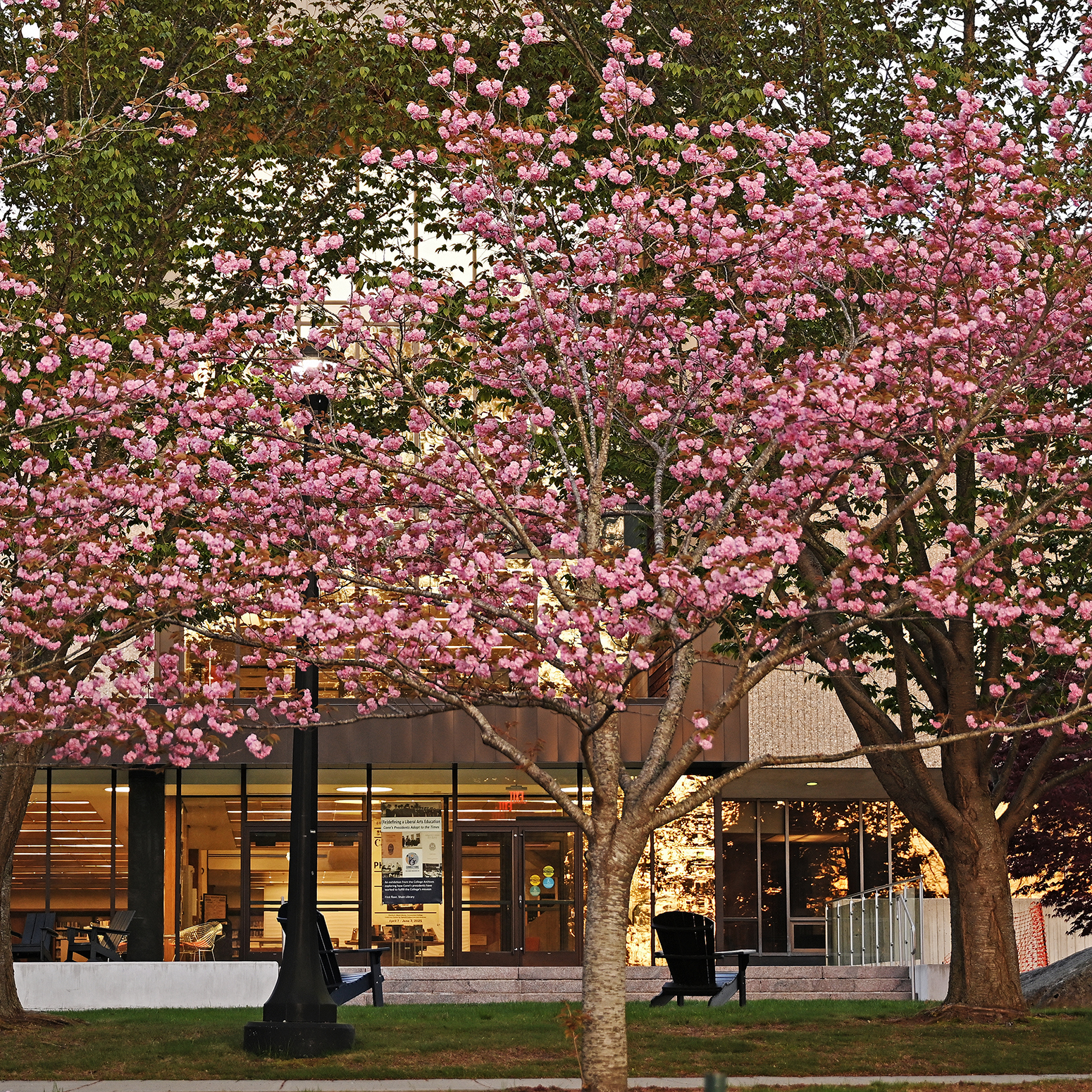
Green Sun
Like a shimmering bed of Onyx, more than 130 sleek black solar panels now adorn the roof of the Service Building, creating an on-site, renewable electricity system. The project was finally brought to fruition after more than a year of planning and design that harnessed the passion and expertise of students, alumni and faculty who are committed to supporting the College’s sustainability plan.
The installation, which took place over the course of two days, was the culmination of an individual study course beginning in the spring of 2020 led by Chad Jones, associate professor of botany and environmental studies, who teamed up with Rocky Ackroyd ’83 and eight students to craft a plan and then navigate the challenges of local building rules and regulations.
Ackroyd, who owns GreenSun, a Maine-based solar company, had been talking to Jones for several years about different ways in which to enhance sustainability education at Conn. In 2019, Ackroyd brought a portable solar array to campus to demonstrate its capabilities and spark interest among students.
“It has been amazing to have students, alumni, staff, and faculty all working together on this project to bring solar energy generation to campus,” Jones said. “I think it has been an amazing learning experience for the students and I know it has been for me.”
Throughout the course, students gained a comprehensive understanding of the technology, planning, regulatory and installation layers of an effective solar project. They learned how the arrangement of panels impacts the amount of energy produced, how to avoid panels shading each other and about different ways of mounting panels on a roof. During the planning phase students used sophisticated online tools with the assistance of Ackroyd to test out a variety of panel arrangements and help estimate the cost and energy output of each layout. Two potential plans were then presented to the leadership of the Facilities department for feedback.
Koby Giglietti ’21, an environmental studies major and economics minor, said he joined the project because he feels strongly that sustainability initiatives like this one send an important message that Conn is truly committed to the values it espouses.
“I think installing solar panels throughout Connecticut College’s campus is special and important because not only does it provide a long term solution to reducing greenhouse gases by capturing a renewable form of electricity offsetting dirty fossil fuels, but it also provides the campus community a sort of culture based on respect in the society that we live in,” Giglietti said.
“As a student body, we should continue advocating for additional renewable practices that can reduce our environmental impact while also reducing the financial burden of purchasing electricity, and these solar panels will offset much of the electricity used at the maintenance building in south lot.”
As a 53-kW system, the new solar array will generate approximately two-thirds of the power required by the service building. Students from the individual study course who graduated in 2020 returned to campus for the installation, including Anna Laprise ’20—who now works at Ackroyd’s solar company—Nate Baretta ’20 and Ashlyn Healey ’20.
Sophie Demaisy ’24, a botany major who volunteered to help with the installation, said she jumped at the opportunity to participate in a sustainability project on campus.
“I had never really thought about how much planning and labor goes into having a building equipped with solar panels,” Demaisy said. “The process was a learning experience, and I enjoyed meeting the recent graduates who took part in the planning process and who showed their devotion and pride. I’m hopeful that I will be able to get involved in other similar projects during my time at Conn and participate in making our campus greener.”
Funding for the solar array was provided by the College’s sustainability revolving fund, which is dedicated to projects that save money long-term and thus can pay back into the fund over time. The cost savings on the College’s electricity bill will be invested back into the revolving fund until the cost of the project is paid back in full, meaning those funds can then be used again for future sustainability projects.
Margaret Bounds, who serves as assistant director of sustainability, suggested that this unprecedented process and collaborative approach can definitely be repeated in the future as the College continues to pursue green technology wherever it can.
“Reducing the greenhouse gas emissions associated with our electricity use is one of the key goals of our campus sustainability plan, and it is really exciting that this collaboration between students, faculty, staff and alumni could be a model for more solar projects on campus,” Bounds said.


